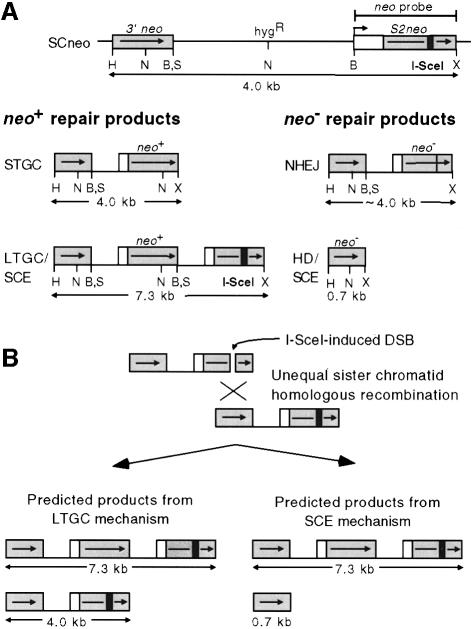Fig. 1. Recombination reporter substrate SCneo. (A) Schematic representation of SCneo and predicted neo+ and neo– DSB repair products after I-SceI expression. Shaded boxes represent the 0.7 kb neo gene repeats and the open box the promoter of the S2neo gene. The small black box is the 18 bp I-SceI site. During a short tract gene conversion (STGC), the I-SceI site is replaced by the NcoI site, but SCneo is not otherwise altered. Both long tract gene conversion and unequal sister chromatid exchange (LTGC/SCE) results in expansion of the SCneo locus. The expansion typically results in the middle neo repeat containing NcoI and SalI sites. Other LTGC products are also possible, depending on the length of the conversion tract. In a non-homologous end joining (NHEJ) event, the I-SceI site is disrupted, as these events usually involve small deletions or insertions. The 0.7 kb product can arise either from a homologous deletion (HD) or as the reciprocal contraction product of an unequal SCE. HD events arise from annealing of single strands at the two neo repeats, such that one repeat and the intervening hyg gene is deleted. The relevant restriction enzyme sites are shown: H, HindIII; N, NcoI; S, SalI; B, BamHI; X, XhoI. (B) Predicted products from two distinct mechanisms of unequal sister chromatid recombination. In an LTGC, the donor of information will remain unaltered during conversion of sequences downstream of the I-SceI site. In an SCE, expansion of one chromatid to a triplication will be associated with contraction on the other chromatid.

An official website of the United States government
Here's how you know
Official websites use .gov
A
.gov website belongs to an official
government organization in the United States.
Secure .gov websites use HTTPS
A lock (
) or https:// means you've safely
connected to the .gov website. Share sensitive
information only on official, secure websites.
